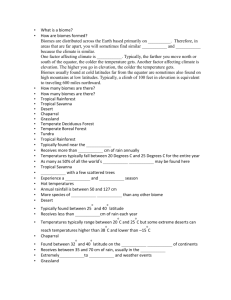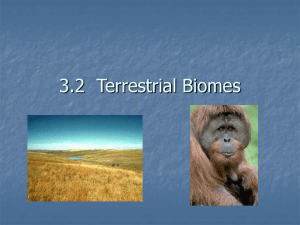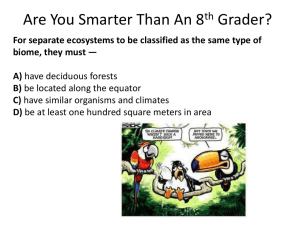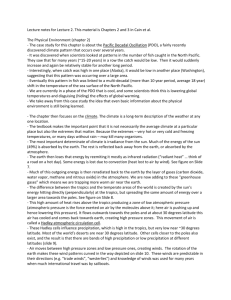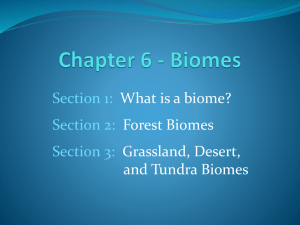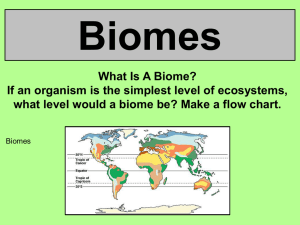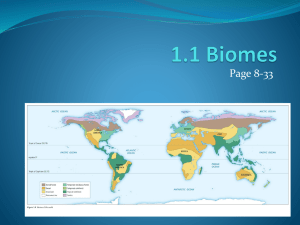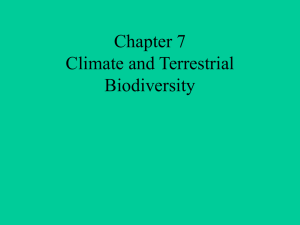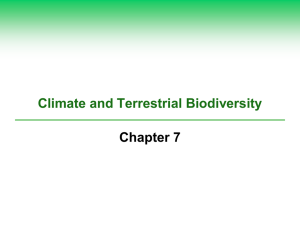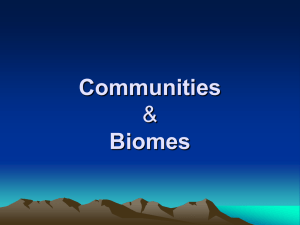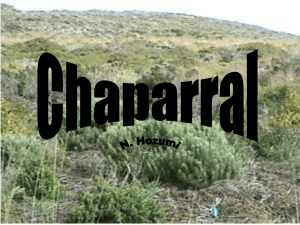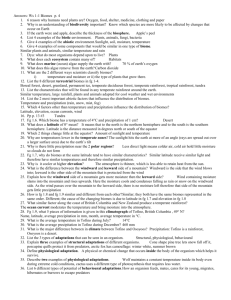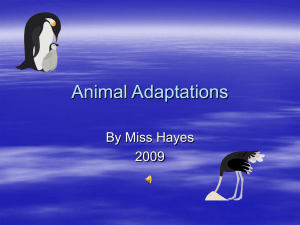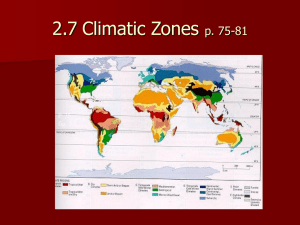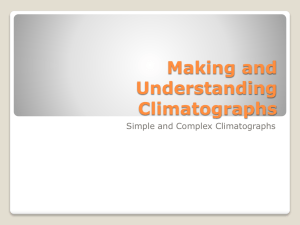Biomes of the World
advertisement
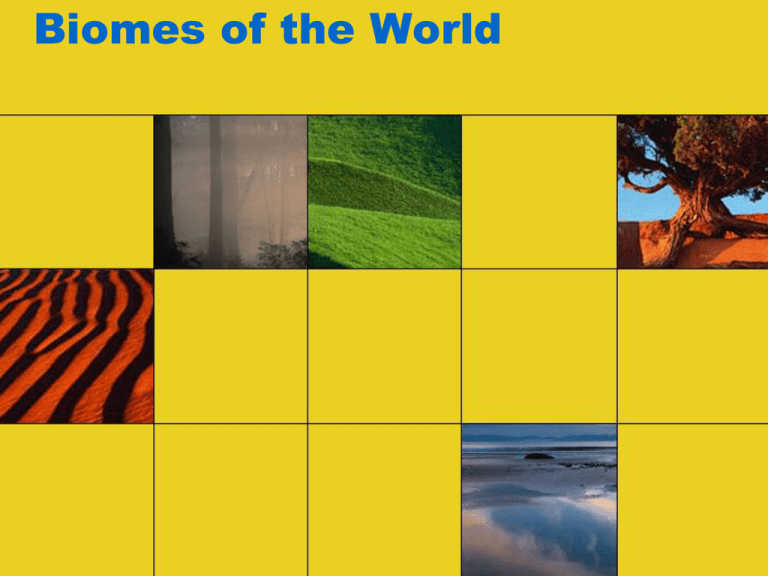
Biomes of the World What is a biome? A BIOME is a large geographic area containing similar plants, animals, and climate. How are biomes formed? CLIMATE: In areas that are far apart, you will sometimes find similar plants and animals because the climate is similar. Latitude affects climate. Typically, the farther you move north or south of the equator, the colder the temperature gets. Biomes are distributed along lines of latitude (deserts typically around 30 degrees N or S). Elevation affects climate. The higher you go in elevation, the colder the temperature gets. Biomes usually found at cold latitudes far from the equator are sometimes also found on high mountains at low latitudes. Typically, a climb of 100 feet in elevation is equivalent to traveling 600 miles northward. How many biomes are there? How many biomes are there? Although there is some disagreement among scientists on how to divide up the Earth’s biomes, most can agree on the following eight: • • • • • • • • Tropical Rainforest Tropical Savanna – in text w/grasslands Desert Chaparral – not in your textbook Grassland Temperate Deciduous Forest Temperate Boreal Forest Tundra Tropical Rainforest • Typically found near the equator • Receives more than 200 cm of rain annually • Temperatures typically fall between 20oC (68oF) and 25oC (77oF) for the entire year • As many as 50% of all the world’s animal species may be found here Tropical Rainforest Conditions requiring special adaptations: • Lots of precipitation • Heavy foliage • Distinct layers • Humid • Others? Tropical Savanna • Grasslands with a few scattered trees • Experience a wet and dry season • Hot temperatures • Annual rainfall as much as 120 cm • More species of grazing mammals than any other biome Tropical Savanna Conditions requiring special adaptations: • Hot climate • Minimal rain with few trees • Others? Desert • Typically found between 25o and 40o latitude • Receives less than 25 cm of rain each year • Temperatures typically range between 20oC (68oF) and 25oC (77oF) but some extreme deserts can reach temperatures higher than 38oC (100oF) and lower than –15oC (5oF) Desert Conditions requiring special adaptations: • Harsh conditions • Little precipitation • Extreme temperature changes • Heat • Others? Chaparral • Found between 32o and 40o latitude on the west coast of continents • Receives between 35 and 70 cm of rain, usually in the winter • Extremely resistant to drought and weather events Chaparral Conditions requiring special adaptations: • Hot • Dry • Others? Grassland • Because of the dry climate, trees are found only near water sources such as streams • Usually receives between 25 and 75 cm of rainfall each year • Summer temperatures can reach up to 38oC (100oF), and winter temperatures can fall to –40oC (-40oF) Grassland Conditions requiring special adaptations: • Moderate climate • Minimal rain with few trees • Others? Temperate Deciduous Forest • Moderate climate with seasonal variations • Most trees will lose their leaves in the winter • Temperatures range between –30oC (-22oF)and 30oC (86oF) • Averages from at least 50 to 150 cm of precipitation • Well developed understory Temperate Deciduous Forest Conditions requiring special adaptations: • Sufficient rainfall for tree growth • Seasons • Others? Temperate Boreal Forest • Also known as Taiga • Typically found between 45o and 60o North latitude • Cold climate with summer rains • Very few reptiles • Limited understory • Snow is primary form of precipitation (40 – 100 cm annually) Temperate Boreal Forest Conditions requiring special adaptations: • Mostly frozen water • Cold climate • Others? Tundra • Means marshy plain • Characterized by permafrost – permanently frozen soil starting as high as a few centimeters below the surface – which severely limits plant growth • Winter temperatures average –34oC (-29oF) while summer temperatures usually average below 10oC (50oF) • Low precipitation (15–25 cm per year) but ground is usually wet because of low evaporation Tundra Conditions requiring special adaptations: • Very cold and dry • Frozen soil • Others? Credits • Text: – http://www.physicalgeography.net/fundamentals/9k.html – http://www.ucmp.berkeley.edu/glossary/gloss5/biome/index.html • Pictures: – http://www.worldbiomes.com/ – http://www.ucmp.berkeley.edu/glossary/gloss5/biome/index.html – http://www.blueplanetbiomes.org/ • PowerPoint: – Arizona Game and Fish Department, 2005
